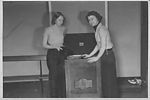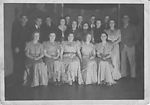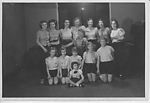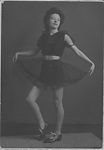 Edna Homer ran a dance academy at the Institute
Edna Homer ran a dance academy at the Institute Edna and best friend Dorothy Hindmarsh at the gramophone
Edna and best friend Dorothy Hindmarsh at the gramophone Dance Class February 1940
Dance Class February 1940 Concert Programme 1947
Concert Programme 1947 Edna's Dance Troop
Edna's Dance Troop Dorothy Hindmarsh
Dorothy Hindmarsh Francis Wilmott
Francis Wilmott Edna 2004
Edna 2004

From 1939 to 1944, whilst billiards and snooker were being played downstairs at the Workers' Institute in Cradley Heath, Edna Homer ran the Edna Homer Dance Academy upstairs. She rented the committee room on the first floor on a weekly basis, where she held dance classes in ballroom, ballet and tap.
Edna’s father, Harry Homer, used to work for William Griffin's, a local chain-making firm. Harry was a member of the Chainmakers' and Strikers' Association. His job involved examining the chains and checking that they complied with the standards laid down by Lloyd's Register.
Edna first went to the Institute, or "Stute" as it was known locally, to see the Saturday afternoon film showing at the "Pictureland" cinema there, just as so many other children in the area did. Edna had always loved dancing, and she took her first dancing steps at the “'Stute” as a little girl of seven, when a man came to teach dancing in the main hall. He taught her clog dancing, and she bought her first pair of “Dutch Sabos” (a type of clog with wooden soles and laces at the front) from Jones’ shoe shop in Reddal Hill Road. Although the young Edna learnt different forms of dance, ballroom was always her favourite, and with her dance partner, Harry Jones, she won a number of local competitions.
Edna's love of dancing inspired her to teach, and it was through her brother-in-law that she came to hire a room at the “'Stute”. Edna was seventeen when she started her dance classes and set up the Edna Homer Dance Academy. The initials E.H.D.A. were displayed on the white blouse she used to wear with her black skirt.
Edna paid rent to Mr Albert Head, “a little man who always wore a bowler hat”. She would take her weekly rent money to Mr Head's house, which was also the Chainmakers' and Strikers' Association's headquarters, at Unity Villas, Cradley Heath.
Edna ran dance classes on and off throughout the week, but Tuesday nights were the most popular. Dance classes were a good way to meet members of the opposite sex. Her best friend, Dorothy Hindmarsh, met her husband there, and Ron Moss, a local historian and author, also met his wife, Sylvia, there. The classes, which taught “strict tempo” dancing, would start at 7.30 p.m. and run until 10.30 p.m. There would be a short interval, when members of the dance class would visit a local hostelry, often the "Railway" on Lower High Street, for some liquid refreshment. Sometimes, they would go to Homer's fish and chip shop across the road from the Institute.
The committee room was laid out with wooden chairs around the edges, and at the side of the room there was a table, where Edna's gramophone would be playing the latest Victor Silvester record. On the right side of the room was a small upright piano, which Edna also used, and on which local pianist Norman Robinson, who came from Dudley Wood, would accompany the dancers. Often on a Saturday morning, the pupils would be queuing outside the front of the “'Stute”, waiting for the class to start.
Edna was strict with her pupils, and she refused to teach them a new step until they had mastered the one they were working on. She used to buy her sheet music and records from a shop called Foley's, which was situated near the four ways junction in Cradley Heath. Her favourite dances were the quickstep and the waltz, and everyone enjoyed taking part in the Lambeth Walk.
Edna kept the dance classes running during the war years, and combined it with her job as a progress clerk at the Austin Motor Factory. There used to be a “heppeny box”, and when dancers bumped into one another they were asked to donate some money. When the collection reached five shillings (25 pence), it was sent to help the war effort.
As well as running dancing classes, Edna managed the “Edna Homer Dance Troop”, a group of, mostly, local women, who performed shows in nearby hospitals, churches and other venues. All the women wore outfits of white blouses and black short skirts. The troop had a mascot, a little girl with dark curly hair.
Edna gave up teaching dancing when she was about twenty-two, and in 1944 married a local businessman, who owned a welding business. The dance school carried on in her name until June 1951. It continued, under different names, until 1955.
Rollover the captions in the box to see the available images in thumbnail format, click the caption to see the full-size image
| Reference: | 702 |
| Keywords: | |
| Archive Ref: | |
| Updated: | Wed 21 May 2008 - 1 |
| Interpretation written by | Louis Howe |
| Author's organisation | Curatorial |
| Organisation's website |